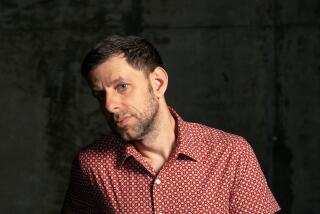Baryshnikov to Leave Ballet Theatre in 1990
- Share via
After 10 years at the helm of American Ballet Theatre, artistic director Mikhail Baryshnikov will step down at the end of the company’s 1990 summer season.
In his present job since September, 1980, the 41-year-old dancer, choreographer and actor announced Wednesday through a company spokesman that he would relinquish his position “in order to pursue other professional options.”
Baryshnikov will remain artistic director of the company through the first phase of the celebrations of its 50th anniversary.
Through the spokesman, Baryshnikov said: “I will have given 10 years to the company, and it has always been a true challenge.”
In the years of his leadership at ABT, Baryshnikov has been credited with refurbishing the repertory and the roster of dancers.
With his background at the Kirov Ballet, the dancer--who defected to the West in 1974 while on tour in Canada--has brought Soviet training and Russian traditions to Ballet Theatre, where the stylistic influences were formerly British and American.
He has also been credited with upgrading the dancing of the corps de ballet, and emphasizing younger--some have said less individual--soloists.
His embracing of the George Balanchine repertory, formerly the province of New York City Ballet (the late Balanchine’s company), gave audiences new perspectives on that body of work. At the same time, Baryshnikov has been accused of neglecting American choreographers, despite his championing of such current dancemakers as Twyla Tharp.
As a dance performer himself--and considered by many the finest danseur in the world--Baryshnikov in recent years has made fewer and fewer appearances.
He was last listed as a dancer on the ABT roster in 1985-86. Since then, he has appeared only sporadically. And in the season 1988-89, he danced with ABT only once--on the June 1 Martha Graham/ABT gala benefit at the Metropolitan Opera House.
On the other hand, Baryshnikov’s activities as an actor--in films, on television and, most recently, on Broadway--have burgeoned.
When he was interviewed by The Times in March, Baryshnikov was appearing eight times a week in the Kafka play “Metamorphosis” at the Ethel Barrymore Theatre in New York.
At that time, the dancer-actor said he would continue to dance, but only selected roles.
“I happen to be in good shape right now,” he said. “My knee (a recurring problem) is OK . . . I don’t want to dance the things that I can’t do as well as I used to. The big bravura ballets like ‘Don Q.’ aren’t for me now. I would rather take another chance and do something that stretches me.
“ ‘What can I do new?’ That is what I always ask. I am talking to (choreographer) Mark Morris. I would like to work again with Jerry Robbins. I am always talking to Twyla (Tharp). We’ll do something together if the knee allows.”
A native of Riga, Latvia, Baryshnikov went to Leningrad at the age of 15 and applied for entrance to the Vaganova School, where he studied for three years with the legendary ballet teacher Alexander Pushkin. At 18, he joined the Kirov company, with which he toured. After his defection, he danced with ABT (1974-78) and New York City Ballet (1978-79).
Baryshnikov’s resignation is expected to complicate further the administrative balance of power at ABT, since it follows by one month the arrival of Jane Hermann as executive director of the company (replacing Charles Dillingham). Hermann, formerly with the Metropolitan Opera, is known as a strong-willed executive. The question is not merely who will replace Baryshnikov as artistic director, but, as the company enters the next decade, how that leader’s style will mesh with Hermann’s.
Times Dance Writer Lewis Segal contributed to this article.
More to Read
The biggest entertainment stories
Get our big stories about Hollywood, film, television, music, arts, culture and more right in your inbox as soon as they publish.
You may occasionally receive promotional content from the Los Angeles Times.










